Випуск 19. Чорна могила
Історія ранньої Русі — її зародження, вибір Середнього Подніпров’я географічним центром, а Києва столицею, утвердження князівської династії, становлення Київської Русі як держави — один із наріжних етапів української історії, який привертає значну увагу навіть людей фахово далеких від цього. Але чи можемо ми показати бодай одну могилу когось із перших князів?
Єдиний давньоруський курган, який усна традиція пов’язує з князем, археологічно досліджений у Чернігові — другому за величиною і значенням центрі Русі. Це так звана Чорна могила, де за переказами похований князь Чорний, засновник міста Чернігова. Не викликає сумніву той факт, що Чорна могила — найграндіозніша з відомих поховальна пам’ятка доби ранньої Русі.
Сьогодні курган Чорна могила є частиною Заповідника «Чернігів Стародавній» і має охоронний номер. Розкопки Чорної Могили ініціював і очолив російський імперський археолог, уродженець Новгород-Сіверського повіту Чернігівської губернії Дмитро Самоквасов. Роботи розпочали у жовтні 1872 р. і завершили у серпні 1873 р. Тож на 2022 рік припадає 150-річний ювілей археологічного відкриття пам'ятки.
Чорна могила знаходиться в межах міста Чернігів, поблизу давньоруського Єлицького монастиря. На початок розкопок курган мав висоту 11 м, окружність 125 м, а з південного і західного боку було помітно рів шириною 7 м. Дослідження виявили складний поховальний обряд-кремацію, локалізований на двох рівнях. Рештки кремації з переважною більшістю знахідок — на десятиметровому кострищі по центру кургану, рештки тризни з дорогоцінними дарами покійнику — на 3,5 м вище в насипу.
Знахідки з поховання Дмитро Самоквасов оприлюднив на ІІІ Археологічному з’їзді 1874 р. у Києві. Ці артефакти швидко стали хрестоматійними.
Серед них — турячі роги з дорогоцінним окуттям із золоченого срібла з черню, золочена бронзова фігурка короля для скандинавської гри hnefatafl, золоті візантійські монети, інкрустовані сріблом залізні жезли владця, списи, шоломи, мечі, шаблі, кольчуги, кінське спорядження, казани, набори для настільних ігор, виготовлені з дорогого у ті часи скла та не менш дорогоцінної моржової кістки.
Ці предмети, очевидно, потрапили у поховання уже після спалення небіжчика, а тому добре збереглися. Інші ж, у тому числі золоті, срібні та скляні прикраси, золототканий одяг з шитвом, мідна курильниця, деталі оздоби поясів, гребені, путало та інші речі з різьбленої кістки, а також численні побутові металеві предмети — сокира, долото, серпи, ножі, замки, ключі, відра та керамічні посудини, — збереглися значно гірше. Деякі металеві речі внаслідок окислення і мінералізації на момент виявлення були спаяні між собою в суцільну масу.
Припускають, що, окрім небіжчика, заради якого його спорудили, у кургані ще був похований хлопчик-підліток та молода жінка. Дійсно, у кургані деякі речі були парними — як то 2 шоломи, 2 мечі, 2 шаблі, 2 кольчуги, 2 владчі жезли. Інші — поділені за призначенням: гральні набори для настільних ігор — для дорослого; набір бабок — для хлопчика; прикраси, серпи та інші побутові речі — для жінки. Традиційно поховання датують 960—970-ми рр. Можна дискутувати, кому належить це поховання, але безперечно одне — людина, похована там, мала найвищий соціальний ранг, тож походила з князівської родини.
Безпосередньо після розкопок знахідки з Чорної могили експонували у Києві та Чернігові. А потому, згідно з правилами Імператорської археологічної комісії (про які вже не раз згадувалося в інших дописах), переважну більшість з них передали до Державного історичного музею в Москві, де вони перебувають й дотепер. Обмаль виявлених речей Дмитро Самоквасов передав до музею Київського університету св. Володимира та деяких приватних колекцій. Однак їхні сліди губляться в роки світових воєн першої половини ХХ ст.
Знахідки з розкопок Чорної могили у Чернігові — це не просто чергова вивезена до Москви колекція археологічних артефактів. Це саме та історія української державності, на яку зазіхає Росія від початків свого існування. Саме для легітимізації назви “Росія”, асоційованої з назвою “Русь”, і потрібні ці артефакти з території України у вітрині Державного історичного музею в Москві (офіційне походження в каталозі росіяни артикулюють як “Російська імперія, Чернігівська губернія, Чернігівський повіт, м. Чернігів”).
Тож артефакти з Чорної могили — беззаперечні свідоцтва величі Київської князівської держави, які росіяни привласнили й безсоромно хизуються ними в музеях й на сторінках своїх підручників з історії Росії.
Наталя Хамайко, молодший науковий співробітник відділу Наукові фонди Інституту археології України та співробітниця Ляйбніц-Інституту історії та культури Центральної та Східної Європи (ГВЦО)
Release 19. Chorna Mohyla
The history of Early Rus encompassing its origin, the choice of the Middle Dnipro region as its geographical center, and Kyiv as the capital, the establishment of the princely dynasty, the formation of Kyivan Rus as a state is one of the cornerstone stages of Ukrainian history. It attracts considerable attention of experts as well as the general public. But can we show at least one grave of one of the first princes?
The only burial mound of the Ancient Rus period that oral tradition connects with the prince has been investigated in Chernihiv, the second largest and most important center of Kyivan Rus. It is the so-called Chorna Mohyla (Black Tomb), where, according to legend, Prince Chorny, the founder of the city of Chernihiv, was buried. Undoubtedly, the Chorna Mohyla is the grandest known burial monument of the Early Rus period.
Today, the Chorna Mohyla burial mound is part of the Ancient Chernihiv National Preserve and has a protection number.
The excavation of the Chorna Mohyla was initiated and led by Dmytro Samokvasov, the Russian imperial archaeologist and a native of the Novgorod-Siversky district of the Chernihiv province. Work began in October 1872 and ended in August 1873. So 2022 marks the 150th anniversary of the archaeological discovery of the Site.
The Chorna Mohyla is located within the boundaries of the city of Chernihiv, near the ancient Yelytsky Monastery. At the beginning of the excavations, the burial mound was 11 m high, 125 m in circumference, and surrounded by a trench 7 m wide visible from the southern and western sides. The research revealed a complex burial rite-cremation, localized on two levels. The remains of the cremation and most of the finds were discovered on a ten-meter pyre in the center of the burial mound. The remains of the funeral banquet with precious gifts to the deceased were found 3.5 m higher in the mound.
The finds from the burial were made public by Dmytro Samokvasov at the 3rd Archaeological Congress of 1874 in Kyiv. These artifacts quickly became textbook example.
Among the finds are bull horns with precious gilt silver plaques with niello, a gilt bronze king figurine for the hnefatafl Scandinavian game, gold Byzantine coins, silver-encrusted iron rods of authority, spears, helmets, swords, sabers, chain mail, horse equipment, cauldrons, sets of board games, made of expensive at that time glass and no less precious walrus bone.
Obviously, these objects got into the burial after the burning of the deceased, and therefore they were well preserved. Other finds, including gold, silver, and glass jewelry, gold-woven clothes with embroidery, a copper censer, details of belt ornaments, combs, a bone tool for untying knots, and other items made of carved bone, as well as numerous household metal objects — axes, chisels, sickles, knives, locks, keys, buckets, and ceramic vessels have been much worse preserved. Some metal objects soldered together into a solid mass due to oxidation and mineralization at the time of discovery.
It is assumed that the deceased for whom the burial mound was erected was buried together with a teenage boy and a young woman. Indeed, some objects in the mound were paired — such as two helmets, two swords, two sabers, two chain mails, and two rods of authority. Other items were divided by purpose: gaming sets for board games — for adults; a set of knucklebones — for a boy; jewelry, sickles, and other household items — for a woman. Traditionally, the burial dates to the 960s and 970s. It can be discussed whom this burial belongs to, but one thing is certain — the person buried there had the highest social rank, so he came from a princely family.
Immediately after the excavations, finds from the Chorna Mohyla were exhibited in Kyiv and Chernihiv. Later, under the rules of the Imperial Archaeological Commission (which have already been mentioned more than once in other releases), most artifacts were transferred to the State Historical Museum in Moscow, where they are still kept. Dmytro Samokvasov transmitted small number of the discovered items to the Museum of the University of St. Volodymyr in Kyiv and to some private collections. However, their traces were lost during the world wars of the first half of the 20th century.
The finds from the archaeological excavation of the Chorna Mohyla in Chernihiv are not just another collection of artifacts brought to Moscow. Since its emergence, Russia has encroached on this history of Ukrainian statehood. The State Historical Museum of Moscow needs these artifacts from the territory of Ukraine displayed in its showcase to legitimize the name “Russia” in association with the name of “Rus”. The Russians indicate the official origin of the artifacts in the catalogue as “Russian Empire, Chernihiv Province, Chernihiv District, City of Chernihiv”.
The artifacts from the Chorna Mohyla are indisputable evidence of the greatness of the Kyiv princely state. Russians appropriated these artifacts and shamelessly flaunted them in museums and on the pages of their textbooks on the history of Russia.
Natalia Khamaiko, Institute of Archaeology, National Academy of Science of Ukraine; Leibniz-Institut für Geschichte und Kultur des östlichen Europa (GWZO)
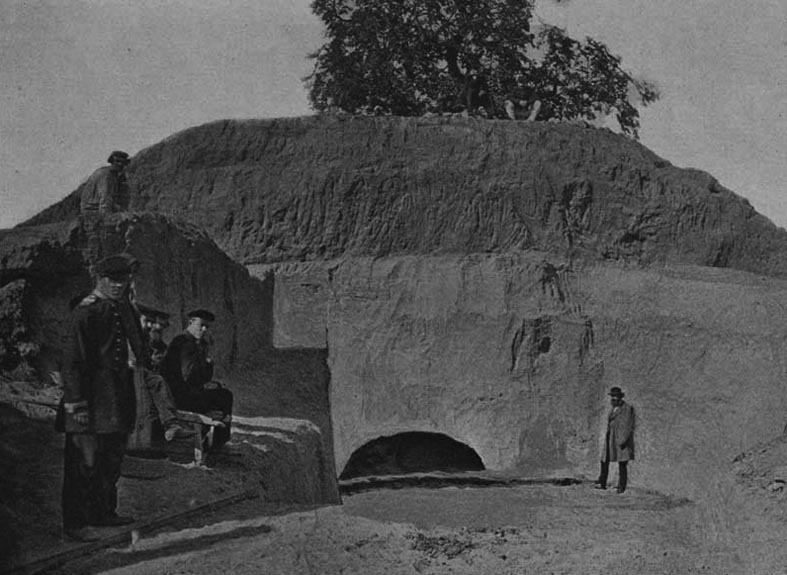
Розкопки Чорної могили в Чернігові. Фото 1893 р.
Excavation of the Chorna Mohyla in Chernihiv. Photo of 1893
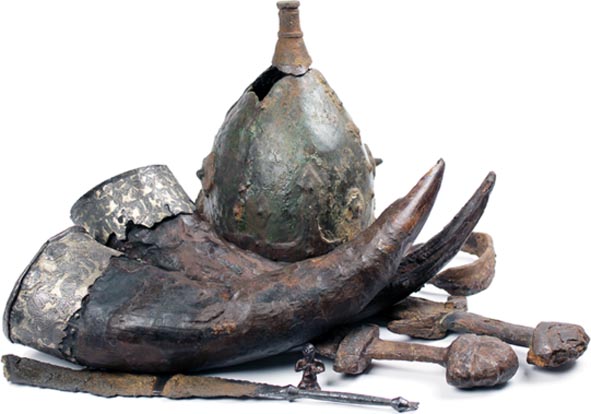
Знахідки з Чорної Могили
Finds from the Chorna Mohyla
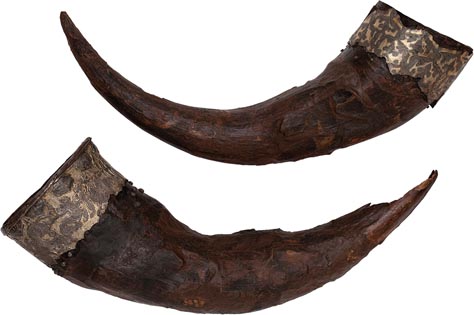
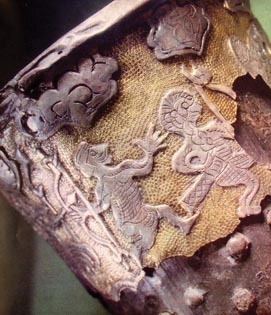
Турячі роги з дорогоцінним окуттям
Bull horns with precious plaques
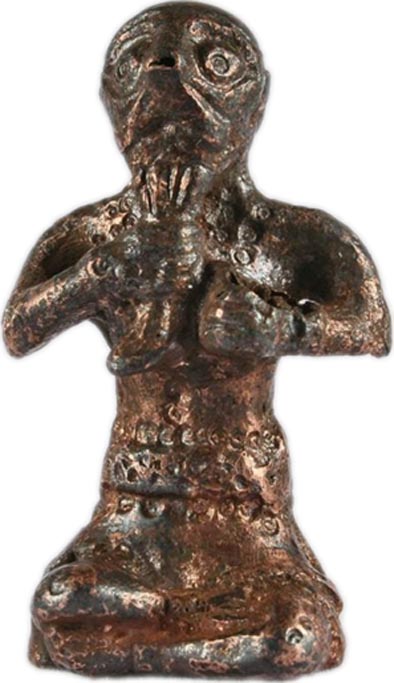
Король для настільної скандинавської гри hnefatafl
King for the hnefatafl Scandinavian board game

Владчі жезли
Rods of authority
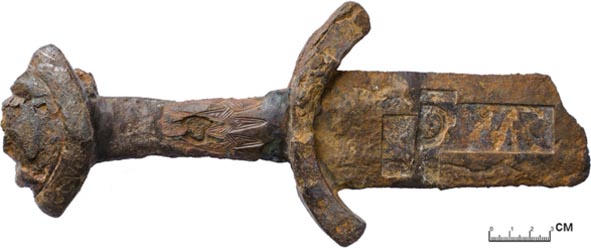
Фрагмент одного з мечів, виявлених у Чорній могилі
Fragment of one of the swords found in the Chorna Mohyla
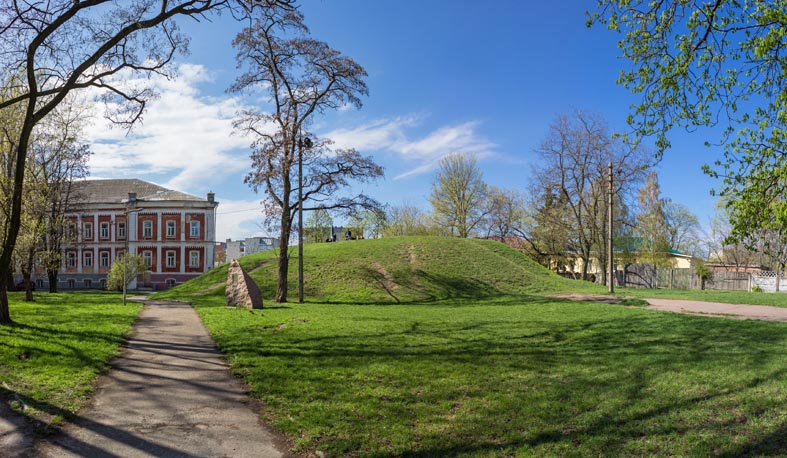
Сучасний вигляд кургану Чорна могила у Чернігові
Modern aspect of the Chorna Mohyla burial mound in Chernihiv
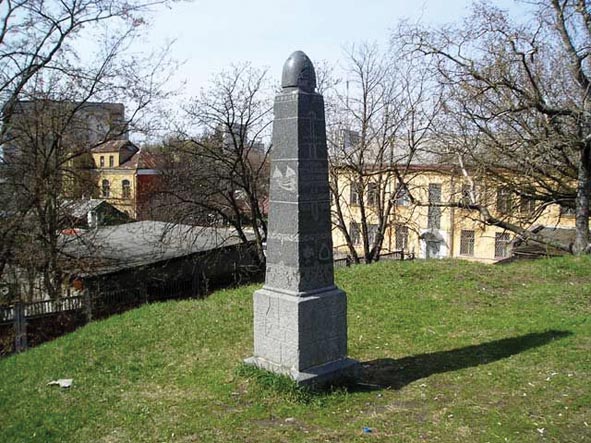
Пам’ятний знак, встановлений на вершині насипу у 1873 р.
The memorial sign installed on the top of the mound in 1873
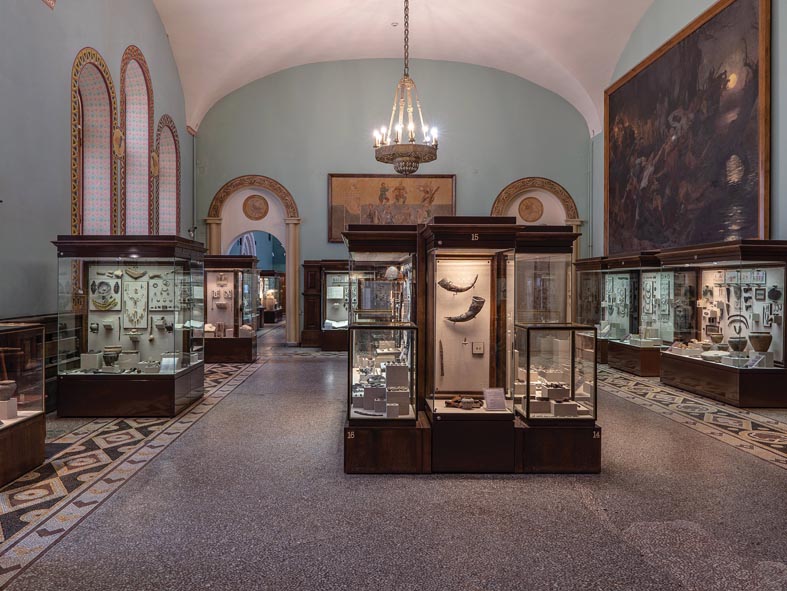
Середньовічна зала Державного історичного музею з вітриною, присвяченою Чорній могилі
Medieval exhibition hall of the State Historical Museum with a showcase dedicated to the Chorna Mohyla
14.01.2023
Проєкт здійснено за підтримки Стабілізаційного фонду культури й освіти Федерального міністерства закордонних справ Німеччини та Goethe-Institut. goethe.de
The project is funded by the Stabilisation Fund for Culture and Education of the German Federal Foreign Office and the Goethe-Institut. goethe.de








